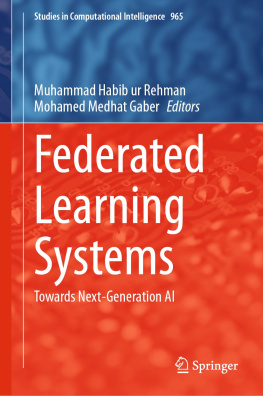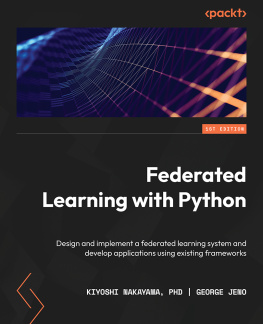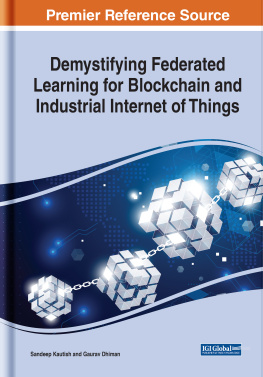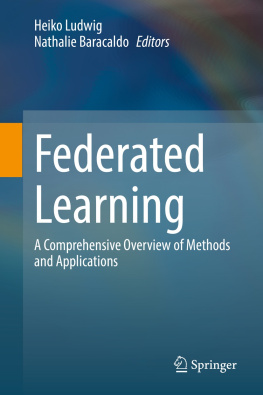Muhammad Habib ur Rehman - Federated Learning
Here you can read online Muhammad Habib ur Rehman - Federated Learning full text of the book (entire story) in english for free. Download pdf and epub, get meaning, cover and reviews about this ebook. year: 2021, publisher: Springer International Publishing, genre: Romance novel. Description of the work, (preface) as well as reviews are available. Best literature library LitArk.com created for fans of good reading and offers a wide selection of genres:
Romance novel
Science fiction
Adventure
Detective
Science
History
Home and family
Prose
Art
Politics
Computer
Non-fiction
Religion
Business
Children
Humor
Choose a favorite category and find really read worthwhile books. Enjoy immersion in the world of imagination, feel the emotions of the characters or learn something new for yourself, make an fascinating discovery.
- Book:Federated Learning
- Author:
- Publisher:Springer International Publishing
- Genre:
- Year:2021
- Rating:5 / 5
- Favourites:Add to favourites
- Your mark:
- 100
- 1
- 2
- 3
- 4
- 5
Federated Learning: summary, description and annotation
We offer to read an annotation, description, summary or preface (depends on what the author of the book "Federated Learning" wrote himself). If you haven't found the necessary information about the book — write in the comments, we will try to find it.
Federated Learning — read online for free the complete book (whole text) full work
Below is the text of the book, divided by pages. System saving the place of the last page read, allows you to conveniently read the book "Federated Learning" online for free, without having to search again every time where you left off. Put a bookmark, and you can go to the page where you finished reading at any time.
Font size:
Interval:
Bookmark:
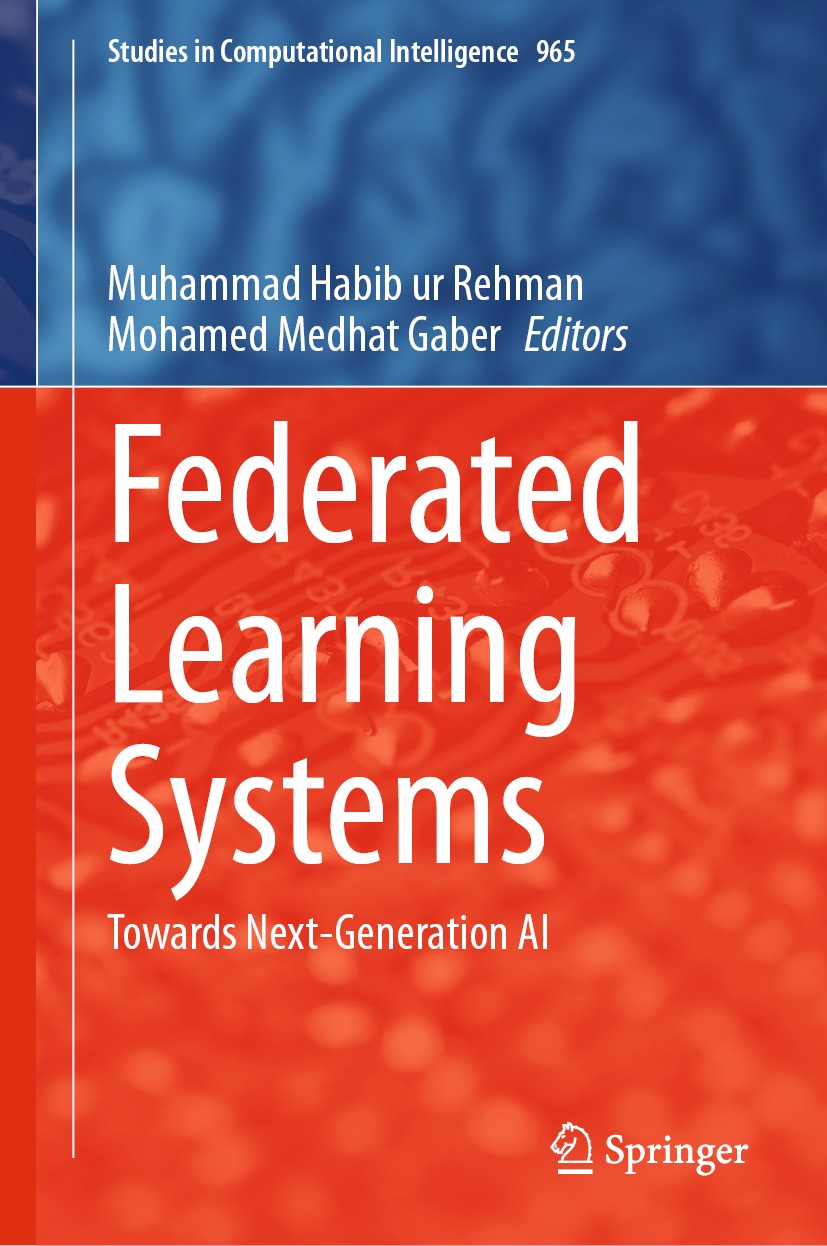
The series Studies in Computational Intelligence (SCI) publishes new developments and advances in the various areas of computational intelligencequickly and with a high quality. The intent is to cover the theory, applications, and design methods of computational intelligence, as embedded in the fields of engineering, computer science, physics and life sciences, as well as the methodologies behind them. The series contains monographs, lecture notes and edited volumes in computational intelligence spanning the areas of neural networks, connectionist systems, genetic algorithms, evolutionary computation, artificial intelligence, cellular automata, self-organizing systems, soft computing, fuzzy systems, and hybrid intelligent systems. Of particular value to both the contributors and the readership are the short publication timeframe and the world-wide distribution, which enable both wide and rapid dissemination of research output.
Indexed by SCOPUS, DBLP, WTI Frankfurt eG, zbMATH, SCImago.
All books published in the series are submitted for consideration in Web of Science.
More information about this series at http://www.springer.com/series/7092

This Springer imprint is published by the registered company Springer Nature Switzerland AG
The registered company address is: Gewerbestrasse 11, 6330 Cham, Switzerland
Businesses and Governments are collecting massive data about their customers and citizens. These organizations store the data in centralized cloud storage infrastructures to perform large-scale training to make complex and timely decisions. This data collection process remains continuous; however, customers and citizens always show their concerns about the data management and processing. Considering this, several regulatory measures were taken and various laws were approved by Governments such as the European Union (GDPR), the United States of America (HIPAA/CCPA), and Canada (PIPDEA). However, still, the customers and citizens are raising concerns over their privacy protection and false decisions made by machine learning systems. Therefore, the inability to collect fresh data poses a serious threat to well-informed and realistic decisions.
Google introduced the term federated learning (FL) to enable the machine learning models to be initially trained at the customers or citizens devices and systems and later the model updates are aggregated at the centralized cloud servers. Considering this notion of FL, a large plethora of research activities has been performed by researchers and practitioners in academia and industry. Hence, numerous research publications were produced to solve the active research issues in terms of privacy, security, data and model synchronization, model development and deployment, personalization, incentivization, and heterogeneity across the FL systems.
This book aims to study the FL ecosystem with a broader perspective to cover the theoretical as well as applied aspects of FL systems. Therefore, this book is structured into eight chapters in total. In the first chapter, Ali et al. performed a thorough bibliometric analysis of the field of FL. Authors have conducted thorough research of the Scopus database to uncover the publication trends. They found 476 scholarly documents in total and then analyzed the dataset to find the growth trends in FL research. Also, they studied subject areas and ranked them in terms of the number of publications. Also, they outlined the top-10 cited papers, top-10 authors, top-10 institutions, and top-10 countries. Moreover, they categorized the documents into various types and then uncovered the top-10 sources of these documents. Finally, the authors have performed the domain profiling of the FL research area and they identified five hot domains such as the internet of things (IoT), wireless communication, privacy and security, data analytics, and learning and optimization, where most of the FL research has been creating impact. Christopher et al., in Chap. , review FL as an approach for performing machine learning on distributed data to protect the privacy of user-generated data. They highlight pertinent challenges in an IoT context such as reducing communication costs associated with data transmission, learning from data under heterogeneous conditions, and applying additional privacy protections to FL. Throughout this review, they identify the strengths and weaknesses of different methods applied to FL, and finally, they outline future directions for privacy-preserving FL research, particularly focusing on IoT applications.
To effectively prevent information leakage, K. Wei et al. (in Chap. ) investigate a differential privacy mechanism in which, at the clients side, artificial noises are added to parameters before uploading. Moreover, they propose a K-client random scheduling policy, in which K clients are randomly selected from a total of N clients to participate in each communication round. Furthermore, a theoretical convergence bound is derived from the loss function of the trained FL model. In detail, considering a fixed privacy level, the theoretical bound reveals that there exist an optimal number of clients
Font size:
Interval:
Bookmark:
Similar books «Federated Learning»
Look at similar books to Federated Learning. We have selected literature similar in name and meaning in the hope of providing readers with more options to find new, interesting, not yet read works.
Discussion, reviews of the book Federated Learning and just readers' own opinions. Leave your comments, write what you think about the work, its meaning or the main characters. Specify what exactly you liked and what you didn't like, and why you think so.

